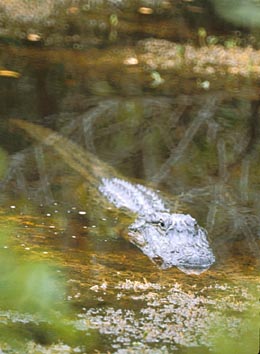
Note: Watch this area for additional navigation information in each section!


Endangered Species at St. Marks National Wildlife Refuge:
St. Marks National Wildlife Refuge currently provides habitat for seven federally-listed endangered species. These species are:
Bald EagleRed-cockaded Woodpecker
Wood Stork
West Indian Manatee
Atlantic Green Turtle
Atlantic Loggerhead Turtle
Leatherback Turtle Two additional federally-listed endangered species, the Florida Panther and Ivory-billed Woodpecker, formally inhabited refuge lands but have not been documented in the area for several decades. The Red Wolf probably also occurred in the area in the past. Endangered Species of the Refuge
- Bald Eagle In 1988, the refuge boasted a healthy bald eagle population which consisted of fourteen active nesting territories that produced 14 young. The bald eagles of the refuge generally forage in and around the managed impoundments and coastal estuaries, where they feed primarily on fish and waterfowl. occasionally the eagles are observed feeding on carrion on the highway right-of-ways. The eagles are migratory and usually arrive on the refuge in September and remain through May. Nesting occurs between December and May although peak populations are noted in the fall and after the eaglets fledge in the spring.
- Red-cockaded Woodpecker The Red-cockaded woodpecker populations on the refuge are mostly located in the Panacea Unit in mesic and wet flatwoods south of Sopchoppy. In 1988, the refuge population included six active nesting sites, which produced ten young. The red-cockaded woodpeckers require old pines, preferably longleaf in excess of 90 years of age, in which to excavate their nesting and roosting cavities in north Florida. They primarily forage for insects and arthropods in the bark of living pines, and tend to prefer pines in excess of nine inches in diameter. Management activities the refuge employs to assist the red-cockaded woodpeckers include: Promoting and perpetuating an old-age longleaf pine forest in open park-like stands; burning to deter invading hardwoods; protecting cavity trees from fire, insects and harvest; protecting active colony sites from disturbance, particularly during the nesting season; and providing adequate foraging habitat in close proximity to colony sites.
- Wood Stork The wood stork is a nonbreeding summer resident of the refuge. The storks generally begin to arrive in April or May and remain until mid-November. They can be found in the St. Marks Unit, where they feed and loaf in the impoundments and tidal marshes, and they can be found in the Panacea Unit, where they roost in the cypress on the northern edge of Otter Lake, and feed in the isolated wetlands and near by tidal marshes. Management practices that benefit the wood storks are those that perpetuate wetland forests, especially cypress, adjacent to bodies of water and the protection of roosting, feeding, and loafing sites from disturbance.
- West Indian Manatee The West Indian Manatee is a large gray-brown aquatic mammal. Its seal-like body tapers to a flat, paddle-shaped tail. The upper part of its body has two small forelimbs with three to four nails on each flipper. The head and face are wrinkled and the snout has stiff whiskers. Adults have been known to reach lengths of over 13 feet and weights of over 3,000 pounds. Calves are three to four feet long and 60 to 70 pounds at birth. They spend most of their time feeding and resting . They graze for food along rivers, coastal bottoms and at the water's surface. Manatees usually arrive off the waters of the refuge in mid April and remain in the vicinity of the refuge and surrounding area until late September and/or early October. The refuge seeks to protect these gentle giants of the coast by enforcing protective-boating regulations; posting reduced boating speed limits and Manatee Alert signs along waterways; and working with state agencies in fostering public awareness and education about the Manatee.
- Atlantic Green Turtle This sea turtle is more common in the Caribbean, although it is often seen swimming off the Florida Gulf Coast. In the past, it was a used as a source of meat and is still considered a delicacy in some parts of the world. The turtle is likewise hunted for its eggs, and it used as a source of leather and jewelry. Refuge management practices include enforcing the Endangered Species Act in carrying out protection measures for this unique sea turtle.
- Atlantic Loggerhead Turtle This is the most common marine turtle encountered in the southeastern U.S., and are frequently observed around wrecks, underwater structures, and reefs, where they forage on a variety of mollusks and crustaceans. Adults can be recognized by their reddish-brown carapace that is elongated and heart-shaped, and by the large head and broad jaws. The most significant threats to loggerheads are coastal development, commercial fisheries, pollution, and collisions with boats. Loggerheads have nested along isolated coastal-areas of the Apalachee Bay in the past. Generally, they tend to migrate into the area around May and remain in the area until August. Like the Atlantic Green Turtle, the refuge provides protection for the Atlantic Loggerhead sea turtles in the form of enforcement of the Endangered Species Act.
- Leatherback Turtle Leatherbacks are the largest of all living turtles, with adults exceeding six feet in length. Nesting females are usually under 1,000 pounds, but males can reach 3,000 pounds. This species of sea turtle derives its name from its unique leathery skin. Unlike other species of sea turtle, the leatherback does not have a solid shell covered with scales. instead, it is covered with a firm, rubbery skin with seven longitudinal ridges. The leatherback turtles are a highly migratory species that nests in the tropics and subtropics and ranges as far north as Canada and the northern Pacific Ocean. The U.S. nesting beaches are found primarily in Florida, Puerto Rico and the U.S. Virgin Islands.












